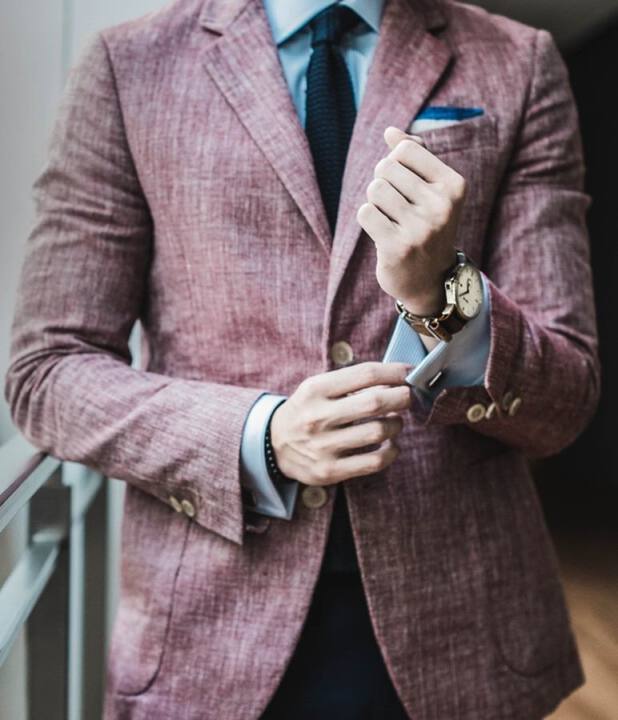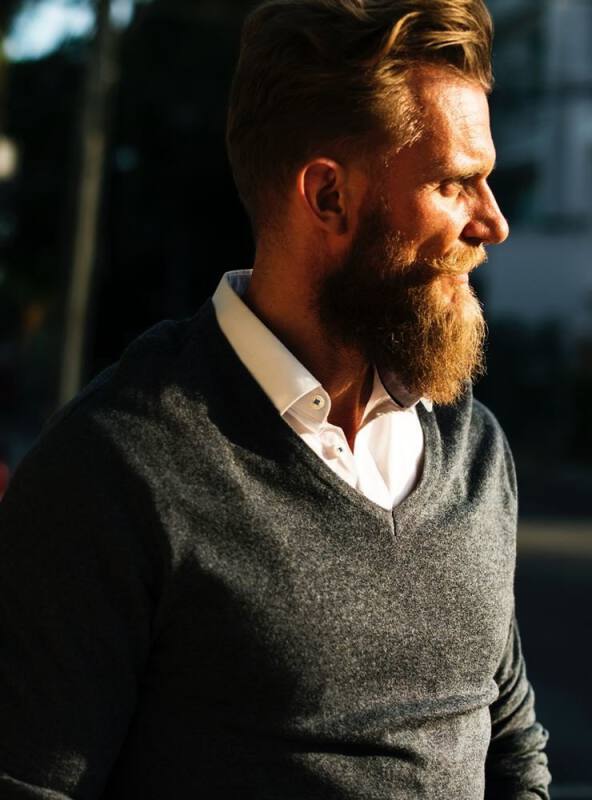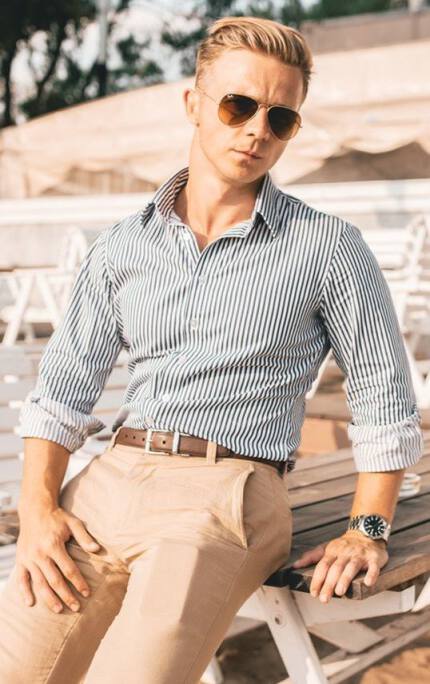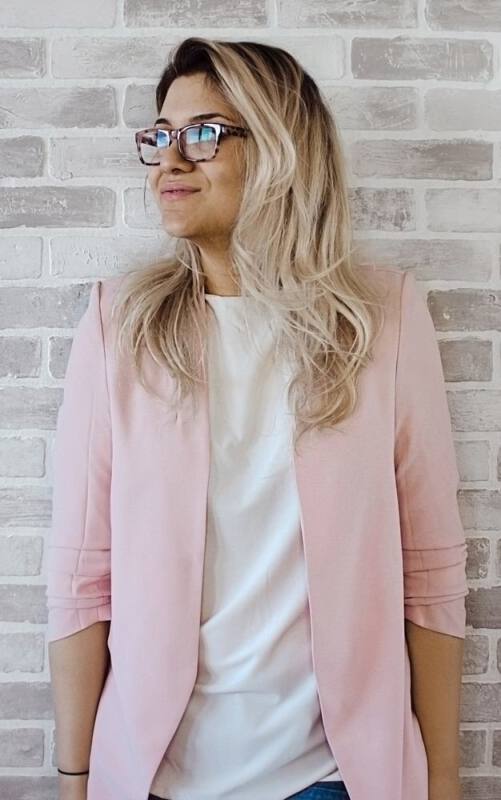
99 LinkedIn Profile Tips: from Summary & Headline to Images
Learn how to use your LinkedIn profile to get job offers from the best companies. Boost your career with these easy LinkedIn profile tips and tricks. Read more!

A job interview is a formal situation. It means men should wear a suit jacket with a shirt and tie and women a suit with a skirt or pants. If you don't know what to wear, ask the recruiter about the dress code.
People tell you to dress for success. “Dress for the job you want, not the job you have.” Makes sense! 55% of first impressions are determined by the way you dress and walk through the door. 65% of hiring managers say clothes are a deciding factor between two candidates.
But no one ever tells you what it is exactly that you should wear to an interview. We’ll fix that. Like Edith Head said, you can have anything you want in life, if you dress for it.
This guide will show you:
Want to save time and have your resume ready in 5 minutes? Try our resume builder. It’s fast and easy to use. Plus, you’ll get ready-made content to add with one click. See 20+ resume templates and create your resume here.
Sample resume made with our builder—See more resume examples here.
1
Dressing up for an interview is all about matching their company culture.
Most offices operate in business professional attire (don’t worry we’ll get into that in less than 50 seconds), but some startups and companies prefer casual outfits in the office (we’ll also give you the deets on this).
If you’re not sure what to wear to your job interview, you could send a quick email to your recruiter to ask about the dress code.
If anything, it will demonstrate your proactive nature and your intentions to do well in your interview.
If for whatever reason you think asking is a bit too out there for you, most companies have social media profiles these days. You could check a few of their employees’ profiles and see what they’re wearing during office hours.
A few companies even have “A day in the life” videos. You could watch a few of those and get an insight of what the office dress code is all about there. Or simply show up during lunch break to assess what everyone wears.
Weird? Perhaps. Foolproof? Most definitely!
If the company feels corporate, then a suit and tie for men or a suit and dress for women is the way to go. If it’s more a-la Zuckerberg, plain t-shirt and casual pants, you know business casual is your friend.
Here is a general guideline of what to wear to an interview according to the industry or department you’re in:
Conservative/ Business Professional | Business Casual | Casual | Creative/ Fashionable |
Corporations Financial institutions Accounting Firms Law Firms High-level governmental institutions | Sales Government agencies Education Retail Small Business Tech Engineering Real Estate | Repair Landscaping Plumbing Construction | Entertainment Fashion Graphic Design Travel Music |
Before we get into the good bits, let’s set a few rules for you to dress to impress:
Pro Tip: After assessing the tone of your prospective company, you should always aim to dress one notch smarter for your interview. But remember, being way too overdressed can be as bad as being underdressed. So do your research!
If you know what all this means, you’re good to go. Start preparing for your interview by studying the most common interview questions:
And learn what questions you don’t have to answer with help from: Illegal Interview Questions an Employer Cannot Ask [So Don't Answer!]
2
Working in a conservative industry or for a big corporate company?
Choosing business professional attire is always a safe bet, even when you don’t know the dress code in the company you’re applying to.
But not to worry, we’ll show you how to rock your business professional attire, even Anna Wintour would be impressed.
Ladies first though. If you’re looking for answers on the gents side, scroll down a bit further for advice and details on business professional ties, suits and shoes for men.
Sometimes you wish you were a man, only a standard pair of shoes, a dashing suit and plain shirt and voila! All ready to seal the deal during the interview. But deciding what to wear for an interview for women doesn’t have to be as complicated as you might think.
Business professional attire is the most formal attire one can wear (weddings notwithstanding), it needs to reflect your personality and competence without going overboard.
Truth is, most everyday outfits women have in their closet can be tweaked and have you interview ready.
Let’s start with business professional suits for women first.
Suits are a staple of a woman’s professional closet. Even Wonder Woman has one!
For women, suits are generally made of a blazer and either a pair of trousers or a skirt in a matching fabric. Here are some guidelines for interview attire to follow.
You’ll feel like you’re the brainchild of Carrie Bradshaw and Michelle Obama (come on, who wouldn’t want to be):

What would women be without a good old dress?
We all have that one dress, often black, that we like to wear on every occasion. But is it interview appropriate?
Let’s find out.
Formal dresses for women are easy to come around. But remember that work dresses shouldn’t be too tight, too short or too revealing. You can, of course, pair them with blazers but be careful that your color coordination is on point.
Avoid the steely gaze of Miranda Priestly and opt out of sleeveless. They’re generally too casual for most offices.

Still hanging on to that black dress of yours? No problem.
A jacket always adds a professional touch to any simple black dress. Paired with a nice pair of shoes and handbag (avoid flashy colors here), it might just be what your day-to-day black dress needs to enter the business professional clan. Keep the look simple, polished and elegant.
Wait—are you more a skirt kinda girl? That works too.
You can never go wrong with a lighter top and black blazer here. Black shoes work well too.
Are you more of a woman who wears the pants?
Joan of Arc would be proud. But unfortunately, it’s not necessarily the easiest option. You need to make sure they’re the right fit.
First of all, you want to avoid pants that are too tight you can’t sit comfortably or so tight you have a visible panty line. If you have a “camel toe” at the crotch or if your pants are “smiling”, your pants are too tight.
A picture is worth a thousand words:

Notice the creases at the crotch, not good...
In contrast, a rise seam that is too long will create bulges at the top. You don’t want that either!
If you can’t pinch at leach an inch of extra fabric on your thighs, your pants might be in the “too tight” category.
Now let’s tackle the shirts.
When it comes to looking for shirts to wear with skirts or professional pants, deciding on what shirt to wear to an interview can be challenging. Whether you go with a classic professional white shirt or a silky colored one, what matters here is to stick with simple.
Avoid flashy colors and logos at all cost. Certain prints can be an option, but if you’re not too sure, don’t risk it.

Now let’s move on to the shoes and let’s address the elephant in the room first.
You don’t have to wear heels to any interview, especially if you’re not comfortable. And even if you’re petite. You don’t want your prospective team or boss remembering you as the wobbly candidate. Not the greatest of impressions if you ask!
When deciding what professional shoes to wear to an interview, make sure your shoes are closed toe, the heel no higher than 3 inches, and in neutral colors. Flats are perfectly acceptable for an interview too.
Leave the flip-flops, Eskimo boots, and Nike in the shoe cabinet. And the sandals are for casual Fridays, not interviews!
3
Not all men have Tom Ford’s fashion acumen and that’s why we’re here!
In a world where most guys wear sneakers and can barely remember how to knot a necktie, a business professional outfit is your chance to look cooler than the rest.
When men are deciding what to wear to an interview, they’re often left with one choice: to suit up. If you work at the C-level of an organization, in law or in finance, the dress code pretty much has one rule only: conservative. If in doubt, always choose a suit.
Your suit should be a two-piece, in either charcoal grey or navy blue. You can also wear navy suits or grey suits with subtle pinstripes. Lighter greys and blues can be worn in spring or summer. But very light suit colors are for garden parties and weddings, not the office.
Good question! Look, wearing a well-fitted black suit won’t make you miss your chance at the interview, but it’s not ideal either. If you can, avoid wearing a black suit. And a black shirt for that matter. Just saying, we never know.
Speaking of shirts and colors…
Solid white and light-to-medium blues would be your best choices. Pink dress shirts look nice, but they tend to be more accepted in England than they are in the United States.
You can either go with barrel or French cuffs, but you could leave the French cuffs to co-workers who have more seniority over you. A younger man wearing French cuffs may be seen as a bit arrogant. Sounds unfair, doesn’t it?
One word: simple. Solids are a preference, but you could do stripes or dots. Unless you’re interviewing to impersonate Ronald McDonald, avoid electric bright colors like yellow, or a flaming red.
This is where men can have some fun when picking what to wear to an interview. The color of your shoes should be either black, brown or burgundy. The rest is up to you. Oxfords, quarter-brogues, whole cuts, Venetian loafers or cap-toes, whatever you fancy.
Pro Tip: If your budget is limited or if you want a few options of interview outfits, you could always get a first-time buyer discount with online retailers. End of stock retailers like TJ Maxx or Century 21 can also be a source of good finds for both men and women.
When making a resume in our builder, drag & drop bullet points, skills, and auto-fill the boring stuff. Spell check? Check. Start building professional resume template here for free.
When you’re done, Zety’s resume builder will score your resume and tell you exactly how to make it better.
4
First of all, let’s address the question all of us had at some point: what the heck is business casual?
The easiest way to think of business casual is a hybrid of business professional and casual wear. You don’t need to wear a full-on suit, but shorts and flip-flops wouldn't be appropriate.
Think button-down long-sleeved shirt or casual blouse with khakis.
When googling around to decide what to wear to an interview, both men and women end up thinking that it’s perfectly okay to wear jeans. But business casual isn’t meant to be a casual look, it’s meant for business purposes.
When deciding what to wear to an interview, always lean towards the business side rather than the casual side.
Some companies allow jeans and you might get away with it, but ask yourself whether you want to wear clothes that you get away with or wear ones that give the most professional impression of you. Plus, you can still gauge what others are wearing once in the office.
Better to be safe, than sorry.
Dress shirts are business casual must-haves for both women and men. Some offices might allow polo shirts in the summer, but once again, don’t risk it for an interview. Wear a shirt when interviewing then once you have a sneak peek of the office style, go for it!
Shirts in conservative colors work for both men and women. And please, tuck it in!
An untucked shirt has no business being in a business casual outfit. Leave your top two buttons undone, unless it’s showing too much chest hair or cleavage, then leave just the top one undone.
We’ve already established that jeans are a no-go, but chinos, dress pants or khakis are a no-brainer. Here, conservative colors are always your best friend. We’re talking navy, camel or grey for example. If you want more colored pants, make sure they’re muted.
That works too. Although if you’re a man reading this, you might want to scroll down a bit further. The blouses or shirts you wear with your pants will most likely pair well with a skirt. Pencil, A-line or pleated skirt in a solid color always works best.
Try avoiding patterns during a first interview and leave your fashionable pieces for when you signed your contract!
Dresses are an easier choice for business casual outfits for women. It’s one item and off you go to work! Here, sleeveless could work. But avoid minis, high-low, and asymmetrical hemlines and go for dresses and skirts just above the knee or below.
It’s still an interview you’re going for!
When deciding what to wear to an interview, the only business casual shoes you want to pick are sneakers. Those Stan Smith are originals after all, and you want to show them off.
But don’t. Seriously, your hiring manager couldn’t care less about your sneaker collection.
Men should consider loafers, oxfords, derbies, and brogues when deciding what to wear to an interview.
If you get a pair in black and another in brown, you have an appropriate pair of shoes to wear with any color of your pants. You might even forget those sneakers for a little while! (Never, you must be screaming)
Women should consider flats, wedges, heels, and boots when picking what to wear to an interview.
Only certain sandals can be worn with your business casual outfits so you might want to stick with flats or less than 3 inches heels. You can spice up the color of your shoes, but neutrals are always a good bet.

Channel the James Bond in you and dazzle them with your effortlessly chic business casual suit. This is a smart one too.
If you end up in an office with a more business professional look, you wouldn’t stick out too much. But if your interview is with laid-back colleagues, you can just lose the jacket, and you’d fit right in.

An odd jacket means a jacket that wasn’t made with a matching pair of pants. So for all of you tweed lovers out there, this is your chance to show off your collection.
Dress pants or chinos work well with any odd jacket. Dress pants are a bit more on the business professional side and chinos are more casual.

This look is for all the casual junkies out there. Yep, looking at you suit snobs!
It’s not as dressed up as the two previous ones but still misleads your interviewer into thinking that you’re a trustworthy professional. If only they knew!

You’re probably sick of seeing Ryan Gosling in every fashion (or not) related article out there, but he does a good job at picking a business casual outfit that doesn’t look that casual.
Or maybe I’m just biased.
In any case, live by this rule: either wear a jacket and tie, or neither. Wearing a tie with this look will make you look boyish. Like your mother dressed you up for your aunt’s wedding. Not exactly the look we want to go for here.

A sleeveless dress might be too much on the casual side, but paired with a blazer, you’re ready to butt heads with Oprah in those fancy billionaire lists.
Ok maybe you won’t have billions coming through in your bank account (or not just yet), but you’ll sure feel like a million bucks.

A basic cardigan is a must in any business casual outfits for women. A simple waist length cardigan or longer one works just fine.
Buttons, no buttons, it doesn’t matter. We just emphasize the right fit. You don’t want to show up for an interview like you’ve stolen your boyfriend’s cardigan.
With longer cardigans, you can even use a skinny belt to add some definition and a different look to an outfit.

This one is an all-star favorite. Wearing a nice blouse with dress pants or chinos doesn’t compromise comfort and is totally business casual. Seriously, men wish they could just show up to an interview like this too.
In colder months, stick with long or ¾ sleeves. For spring and summer, short or cap sleeves work well. Keep your neckline somewhat modest with a collared, boat neck, square neck, or turtleneck.

I mean how comfy and professional does this look.
Simple, professional, not too casual, not too stuck up.
Fine-gauge knits work best. Bulky sweaters not so much. You can wear well-fitted sweaters with pants, skirts, or even over a dress.
Pro Tip: When deciding what colors to wear to an interview, you should always go for colors that go with your skin tone. Nudes and solid colors are every man and woman’s best friends. Leave the bold choices to when you actually know if the dress code allows it.
5
How to wear your hair for an interview can be a bit of a daunting question.
If you’re a man, then it’s pretty straightforward. Err on the safe side with a clean, neat and well-maintained haircut. Also, put your best self forward and shave, it’s that simple. And send a selfie to your mom, she’ll be proud!
If you’re a woman, it gets a bit more trickier.
If you’re more “Becky with the good hair,” then you can rock your long (or short) hair don’t care, as long as it’s combed, fresh and sleek. Controlled waves can also look elegant, so don’t worry too much about wearing your hair all natural.
A bun or ponytail look also works for both short and long hair. Getting a blow out will give you that extra boost of confidence before an interview for sure!
Whatever style you’re going for, make sure it’s polished and you’ll sure be ready to get that interview.
Mmh, tricky tricky one. The general consensus is to cut it. Don’t start crying just yet though, you could get away with wearing it in a tight bun. But wearing it loose is unfortunately not acceptable in various industries. Sorry, bruh!
In terms of makeup, keep it simple. This isn’t the time to experiment with different looks. If you usually know how to rock a red lip, then go for it. But if you’re a newbie, please don’t even try. Not the day of your interview.
Stick to nudes and warm colors and tone down the glamorous eyeshadow, you’ll have plenty of other occasions to use that Huda beauty palette at the annual gala if you get the job.
Pro Tip: Your hair and face aren’t the only ones you need to care for here. Make sure your hands are well-kept and your nails are trimmed. If you’re a woman and really insist on having some colors popping, stick to sheer colors, taupe, beige or clear nail polish and ensure your nails are well-manicured.
6
All of us, at some point in our lives, have watched an episode or two of any makeover show. Come on, you don’t have to be a heavy binge watcher to know what I’m talking about.
Can you at least picture that before stage?
That’s exactly how we don’t want you to show up at your interview.
Here is what NOT to wear to an interview:
Pro Tip: Avoid wearing brand names, designer names or labels. All the attention needs to be on you and what you have to offer, not the brands you choose to wear. And making it obvious that you like fancy designers won’t guarantee you the job either!
Plus, a great cover letter that matches your resume will give you an advantage over other candidates. You can write it in our cover letter builder here. Here's what it may look like:
See more cover letter templates and start writing.
When deciding what to wear to an interview, avoid a fashion interview faux pas by sticking with simple and sleek choices. This is not the time to play around with your style or be adventurous. Let’s leave that to when you start cashing on the checks of your new job!
Here are a few things to remember:
What’s your favorite job-winning outfit? Ever got in trouble because you wore something that made you stand out for all the wrong reasons? Share your experience in the comments!
Learn how to use your LinkedIn profile to get job offers from the best companies. Boost your career with these easy LinkedIn profile tips and tricks. Read more!
Once you’ve submitted your job application, don’t just sit and wait. Employers expect you to follow up! This guide will show you how to do it right, beat your competition, and land that dream job. Use our sample resume follow-up email, see a follow-up phone call script and learn the most effective follow-up hacks and tips.
To your interview bring a pen, 3 copies of your resume, and a list of references. Optionally, take a folder or portfolio, pack of chewing gum, and a list of question to the interviewer.

